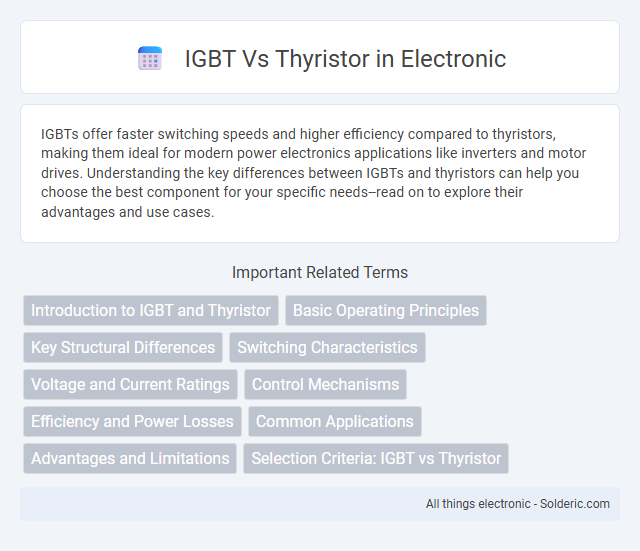IGBTs offer faster switching speeds and higher efficiency compared to thyristors, making them ideal for modern power electronics applications like inverters and motor drives. Understanding the key differences between IGBTs and thyristors can help you choose the best component for your specific needs--read on to explore their advantages and use cases.
Comparison Table
| Feature | IGBT (Insulated Gate Bipolar Transistor) | Thyristor |
|---|---|---|
| Switching Speed | High (microseconds) | Low (milliseconds) |
| Control | Voltage-controlled (Gate) | Current-controlled (Gate trigger) |
| Turn-off Capability | Yes (self turn-off) | No (requires external circuit) |
| Applications | Inverters, Motor drives, UPS | AC/DC converters, Motor control, HVDC |
| Voltage Rating | Up to 1.7 kV | Up to 5 kV and beyond |
| Current Rating | Medium to high | High (hundreds of amperes) |
| Efficiency | High | Moderate |
| Cost | Higher | Lower |
| Overcurrent Handling | Better | Less robust |
Introduction to IGBT and Thyristor
Insulated Gate Bipolar Transistor (IGBT) and Thyristor are semiconductor devices widely used in power electronics for switching and control applications. IGBT combines high input impedance of MOSFETs with the low on-state conduction losses of bipolar transistors, enabling efficient switching at high frequencies. Thyristors, including Silicon Controlled Rectifiers (SCRs), operate as latching devices primarily used in high-voltage, high-current applications with slower switching speeds.
Basic Operating Principles
IGBTs (Insulated Gate Bipolar Transistors) operate as voltage-controlled switches combining MOSFET input characteristics with bipolar transistor output for efficient switching and amplification. Thyristors, on the other hand, are latching devices triggered by a gate pulse and remain conducting until the current drops below a holding value. Understanding the basic operating principles of IGBT vs Thyristor is essential for selecting the right semiconductor switch in power electronics based on switching speed, control, and load type.
Key Structural Differences
Insulated Gate Bipolar Transistors (IGBTs) feature a gate-controlled MOS structure combined with bipolar transistor layers, enabling fast switching and high efficiency. Thyristors consist of four-layer PNPN semiconductor structures with three junctions, controlled only by a gate pulse to trigger conduction and requiring the current to drop below a threshold to turn off. The IGBT's design supports voltage control and rapid turn-off, whereas thyristors rely on current-based latching and slower switching characteristics.
Switching Characteristics
IGBTs exhibit faster switching characteristics with lower turn-off losses compared to thyristors, making them ideal for high-frequency applications. Thyristors, while robust for high voltage and current, have slower switching speeds and require external circuits for turn-off control. Your choice depends on the application's switching speed demands and efficiency requirements.
Voltage and Current Ratings
IGBTs typically offer voltage ratings up to 1,200V to 6,500V and current ratings from tens to several hundred amperes, making them suitable for medium- to high-power applications with faster switching capabilities. Thyristors, in contrast, can handle much higher voltages, often exceeding 5,000V and currents in the kiloampere range, ideal for high-power, slow-switching industrial systems like motor drives and power grids. Your choice between IGBT and Thyristor depends on the specific voltage and current demands of your application, balancing performance with electrical requirements.
Control Mechanisms
IGBTs utilize gate voltage to rapidly switch on and off, allowing precise control of power with high efficiency and fast switching speeds. Thyristors rely on a gate signal to initiate conduction but require the current to fall below a threshold to turn off, limiting their switching flexibility. Your choice between IGBT and thyristor control mechanisms impacts the efficiency and responsiveness of power electronic systems.
Efficiency and Power Losses
Insulated Gate Bipolar Transistors (IGBTs) exhibit higher efficiency and lower power losses compared to Thyristors due to their faster switching capabilities and reduced conduction losses. IGBTs operate effectively at high frequencies, minimizing switching losses, whereas Thyristors, typically used in slower switching applications, generate more heat and suffer from higher power dissipation. These characteristics make IGBTs preferable for applications demanding high efficiency and low energy consumption, such as inverters and motor drives.
Common Applications
IGBTs are commonly used in high-efficiency motor drives, electric vehicle inverters, and renewable energy systems due to their fast switching and high voltage capabilities. Thyristors find frequent application in industrial power control, such as in AC/DC converters, high-power rectifiers, and controlled switching for heating elements. Your choice depends on the need for precise control and switching speed, with IGBTs favored for dynamic applications and thyristors preferred for robust, high-current operations.
Advantages and Limitations
IGBTs offer faster switching speeds and higher efficiency compared to thyristors, making them ideal for applications requiring precise control and reduced power loss, such as inverters and motor drives. Thyristors excel in high-voltage, high-current applications with robust durability and cost-effectiveness but suffer from slower switching and lack of turn-off capability without external circuits. Despite IGBTs' superior performance in modern electronics, their thermal management and higher cost remain notable limitations relative to the simpler, rugged thyristors.
Selection Criteria: IGBT vs Thyristor
IGBTs offer faster switching speeds and higher efficiency, making them ideal for applications requiring precise control and rapid response, such as variable frequency drives and inverter circuits. Thyristors excel in high-voltage, high-current applications due to their robust design and ability to handle large power loads with simpler gate control, commonly used in controlled rectifiers and power switching. When selecting between IGBT and Thyristor, consider factors like switching frequency, voltage levels, power ratings, and your system's efficiency requirements to ensure optimal performance and longevity.
IGBT vs Thyristor Infographic

 solderic.com
solderic.com